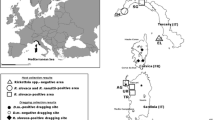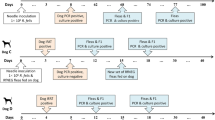Abstract
Rickettsia conorii is widely distributed in Europe, Asia, and Africa. The brown dog tick, Rhipicephalus sanguineus, is the recognized vector of R. conorii. In this study, we assessed the efficiency of R. conorii israelensis transmission between co-feeding Rh. sanguineus ticks. Infected Rh. sanguineus adults and uninfected nymphs were fed simultaneously upon either naïve dogs or a dog previously exposed to this agent. When ticks were placed upon naïve dogs, 92–100% of nymphs acquired the infection and 80–88% of infected engorged nymphs transmitted it transstadially. When ticks were placed upon a seropositive dog, only 8–28.5% of recipient nymphs became infected. Our results establish the first evidence for efficient natural transmission of R. conorii israelensis between co-feeding ticks upon both naïve and seropositive dogs. This route of transmission can ensure continuous circulation of R. conorii israelensis in tick vectors even in the absence of naïve reservoir hosts.
Similar content being viewed by others
References
Ackerman S, Clare FB, McGill TW et al (1981) Passage of host serum components, including antibody, across the digestive tract of Dermacentor variabilis (Say). J Parasitol 67:737–740
Alekseev AN, Chunikhin SP (1990) Exchange of the tick-borne encephalitis virus between Ixodidae, simultaneously feeding on the animals with subthreshold levels of viremia [Russian]. Med Parazitol Parazit Bolezn 59:48–50
Alekseev AN, Chunikhin SP (1991) Virus exchange between feeding ticks in the absence of viremia in a vertebrate host (distant transmission) [Russian]. Med Parazitol Parazit Bolezn 60:50–54
Alekseev AN, Chunikhin SP (1992) Differences in the distant transmission of the tick-borne encephalitis virus by ixodid ticks of two subfamilies [Russian]. Parazitologiia 26:506–515
Bacellar F, Nuncio MS, Rehacek J et al (1991) Rickettsiae and rickettsioses in Portugal. Eur J Epidemiol 7:291–293
Baldridge GD, Kurtti TJ, Burkhardt N et al (2007) Infection of Ixodes scapularis ticks with Rickettsia monacensis expressing green fluorescent protein: a model system. J Invertebr Pathol 94:163–174
Ben-Yakir D (1989) Quantitative studies of host immunoglobulin G in the hemolymph of ticks (Acari). J Med Entomol 26:243–246
Ben-Yakir D, Fox CJ, Homer JT et al (1987) Quantification of host immunoglobulin in the hemolymph of ticks. J Parasitol 73:669–671
Bernasconi MV, Casati S, Peter O et al (2002) Rhipicephalus ticks infected with Rickettsia and Coxiella in Southern Switzerland (Canton Ticino). Infect Genet Evol 2:111–120
Blanc G, Caminopetros J (1932) Epidemiological and experimental studies on Boutonneuse fever done at the Pasteur Institute in Athens. Arch Inst Pasteur Tunis 20:343–394
Brossard M, Rais O (1984) Passage of hemo lysins through the mid gut epithelium of female Ixodes ricinus fed on rabbits infested or reinfested with ticks. Experientia 40:561–563
Chinzei Y, Minoura H (1987) Host immunoglobulin G titre and antibody activity in haemolymph of the tick, Ornithodoros moubata. Med Vet Entomol 1:409–416
Chunikhin SP (1990) Experimental research on the ecology of the tick-borne encephalitis virus [Russian]. Vopr Virusol 35:183–188
de Silva AM, Telford SR III, Brunet LR et al (1996) Borrelia burgdorferi OspA is an arthropod-specific transmission- blocking Lyme disease vaccine. J Exp Med 183:271–275
Eremeeva ME, Dasch GA, Silverman DJ (2003) Evaluation of a PCR assay for quantitation of Rickettsia rickettsii and closely related spotted fever group rickettsiae. J Clin Microbiol 41:5466–5472
Fikrig E, Telford SR 3d, Barthold SW et al (1992) Elimination of Borrelia burgdorferi from vector ticks feeding on OspA-immunized mice. Proc Natl Acad Sci USA 89:5418–5421
Fujisaki K, Kamio T, Kitaoka S (1984) Passage of host serum components, including antibodies specific for Theileria sergenti, across the digestive tract of argasid and ixodid ticks. Ann Trop Med Parasitol 78:449–450
Gern L, Rais O (1996) Efficient transmission of Borrelia burgdorferi between cofeeding Ixodes ricinus ticks (Acari: Ixodidae). J Med Entomol 33:189–192
Giammanco GM, Mansueto S, Ammatuna P et al (2003) Israeli spotted fever Rickettsia in sicilian Rhipicephalus sanguineus ticks. Emerg Infect Dis 9:892–893
Jain SK, Khan JA, Mittal V et al (2008) Indian tick typhus mimicking as rocky mountain spotted fever: a case report. J Commun Dis 40:83–85
Jones LD, Davies CR, Steele GM et al (1987) A novel mode of arbovirus transmission involving a nonviremic host. Science 237:775–777
Jones LD, Davies CR, Williams T et al (1990) Non-viraemic transmission of Thogoto virus: vector efficiency of Rhipicephalus appendiculatus and Amblyomma variegatum. Trans R Soc Trop Med Hyg 84:846–848
Jones LD, Gaunt M, Hails RS et al (1997) Transmission of Louping ill virus between infected and uninfected ticks co-feeding on mountain hares. Med Vet Entomol 11:172–176
Kocan KA, de la Fuente J (2003) Co-feeding studies of ticks infected with Anaplasma marginale. Vet Parasitol 112:295–305
Labuda M, Jones LD, Williams T et al (1993a) Efficient transmission of tick-borne encephalitis virus between cofeeding ticks. J Med Entomol 30:295–299
Labuda M, Nuttall PA, Kozuch O et al (1993b) Non-viraemic transmission of tick-borne encephalitis virus: a mechanism for arbovirus survival in nature. Experientia 49:802–805
Lennette EH, Lennette DA, Lennette ET (1995) Diagnostic procedures for viral, rickettsial, and chlamydial infections. American Public Health Association, Washington, DC, 633 pp
Levin ML, Fish D (2000) Immunity reduces reservoir host competence of Peromyscus leucopus for Ehrlichia phagocytophila. Infect Immun 68:1514–1518
Levin ML, Killmaster LF, Zemtsova G et al (2009) Incongruent effects of two isolates of Rickettsia conorii on the survival of Rhipicephalus sanguineus ticks. Exp Appl Acarol 48:347–359
Matsumoto K, Ogawa M, Brouqui P et al (2005) Transmission of Rickettsia massiliae in the tick, Rhipicephalus turanicus. Med Vet Entomol 19:263–270
Mbogo SK, Osir EO, Mongi AO (1992) Host immunoglobulin G in the haemolymph of the brown ear tick, Rhipicephalus appendiculatus (Neumann, 1901). Insect Sci Appl 13:481–485
Mumcuoglu KY, Keysary A, Gilead L (2002) Mediterranean spotted fever in Israel: a tick-borne disease. IMAJ 4:44–49
Neitz WO, Alexander RA, Mason JH (1941) The transmission of tick-bite fever by the dog tick Rhipicephalus sanguineus. Onderstepoort J Vet Sci Anim Indust 16:9–17
Ogden NH, Nuttall PA, Randolph SE (1997) Natural Lyme disease cycles maintained via sheep by cofeeding ticks. Parasitology 115:591–599
Peter O, Burgdorfer W, Aeschlimann A et al (1984) Rickettsia conorii isolated from Rhipicephalus sanguineus introduced into Switzerland on a pet dog. Z Parasit 70:265–270
Péter O, Raoult D, Gilot B (1990) Isolation by a sensitive centrifugation cell culture system of 52 strains of spotted fever group rickettsiae from ticks collected in France. J Clin Microbiol 28:1597–1599
Piesman J, Happ CM (2001) The efficacy of co-feeding as a means of maintaining Borrelia burgdorferi: a North American model system. J Vector Ecol 26:216–220
Psaroulaki A, Loukaidis F, Hadjichristodoulou C et al (1999) Detection and identification of the aetiological agent of Mediterranean spotted fever (MSF) in two genera of ticks in Cyprus. Trans R Soc Trop Med Hyg 93:597–598
Randolph SE, Gern L, Nuttall PA (1996) Co-feeding ticks: epidemiological significance for tick-borne pathogen transmission. Parasitol Today 12:472–479
Raoult D, Tissot Dupont H, Caraco P et al (1992) Mediterranean spotted fever in Marseille: descriptive epidemiology and the influence of climatic factors. Eur J Epidemiol 8:192–197
Richter D, Allgower R, Matuschka FR (2002) Co-feeding transmission and its contribution to the perpetuation of the Lyme disease spirochete Borrelia afzelii. Emerg Infect Dis 8:1421–1425
Schwartz I, Varde S, Nadelman RB et al (1997) Inhibition of efficient polymerase chain reaction amplification of Borrelia burgdorferi DNA in blood-fed ticks. Am J Trop Med Hyg 56:339–342
Socolovschi C, Bitam I, Raoult D et al (2009) Transmission of Rickettsia conorii in naturally infected Rhipicephalus sanguineus. Clin Microbiol Infect 15:319–321
Tarasevich IV, Mediannikov OY (2006) Rickettsial diseases in Russia. Ann NY Acad Sci 1078:48–59
Tringali G, Intonazzo V, Perna AM et al (1986) Epidemiology of boutonneuse fever in western Sicily. Distribution and prevalence of spotted fever group rickettsial infection in dog ticks (Rhipicephalus sanguineus). Am J Epidemiol 123:721–727
Troughton DR, Levin ML (2007) Life cycles of seven ixodid tick species (Acari: Ixodidae) under standardized laboratory conditions. J Med Entomol 44:732–740
Zhu Y, Fournier PE, Eremeeva M et al (2005) Proposal to create subspecies of Rickettsia conorii based on multi-locus sequence typing and an emended description of Rickettsia conorii. BMC Microbiol 5:1–11
Acknowledgments
We thank Davidia N. Grant and Maria L. Zambrano for their invaluable help with handling live ticks and robotic equipment. We gratefully acknowledge Dr. Sandor E. Karpathy, Dr. Marina Eremeeva, and Dr. Gregory Dasch for their contributions to this study.
Author information
Authors and Affiliations
Corresponding author
Additional information
The findings and conclusions described in this manuscript are those of the authors and do not necessarily represent the views of the Centers for Disease Control and Prevention and the Department of Health and Human Services.
Rights and permissions
About this article
Cite this article
Zemtsova, G., Killmaster, L.F., Mumcuoglu, K.Y. et al. Co-feeding as a route for transmission of Rickettsia conorii israelensis between Rhipicephalus sanguineus ticks. Exp Appl Acarol 52, 383–392 (2010). https://doi.org/10.1007/s10493-010-9375-7
Received:
Accepted:
Published:
Issue Date:
DOI: https://doi.org/10.1007/s10493-010-9375-7




